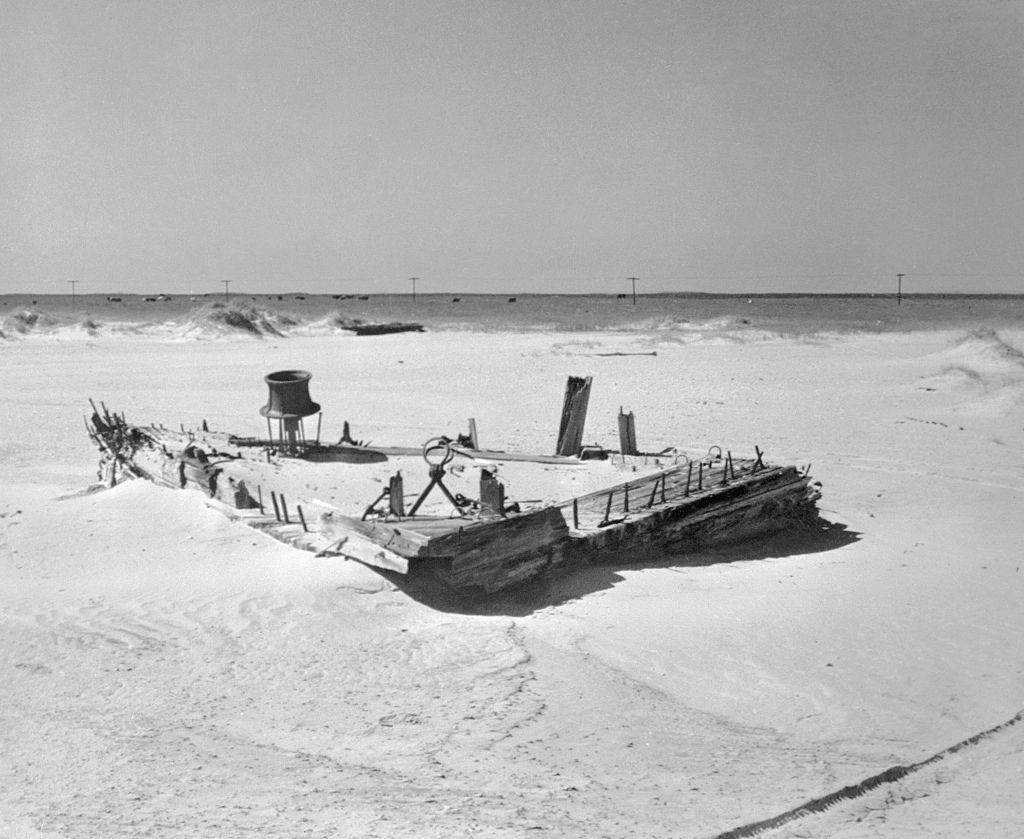
Here is the wreckage of the ghost ship, the Carroll A. Deering, out of Bath, Maine. The ship was found on Diamond Shoals in 1921, undamaged, with sails set, with uneaten food on the table and on the stove, and with only a cat to greet the Coast Guard crew which boarded her. (Bettmann/Bettmann/Getty Images)
What happened to the Carroll A. Deering, the “Ghost Ship of the Outer Banks”?
When a ship’s crew disappears without a trace, countless explanations are bound to emerge. From believable arguments about the weather to ideas that lean into piracy, these explanations can be denied for any number of reasons. In the case of the Outer Banks’ Carroll A. Deering, lingering doubts are rooted in the fact that, while many of the causes for the crew’s mysterious disappearance can be denied, none of them have ever been confirmed, either.
It makes sense that a crew would abandon ship when faced with hurricane conditions. But why would they prepare food—as if they were about to sit down to eat at any moment—before collecting all their personal belongings in a hurry, ready to flee? A logical explanation exists for this. Stormy conditions can change suddenly, especially if you’re unfamiliar with the waters you’re sailing. And yet, another question pops up in its place: Why would you rush to leave due to unsafe conditions, but leave the ship’s cat behind?
This web of interconnected questions is something that many historians, locals, and curious minds have been trying to answer for 100 years. I’d love to say that I cracked the case—that I found an answer buried deep by the passage of time, or discovered a clue no one had come across before—but I haven’t.
What happened to the Carroll A. Deering, the “Ghost Ship of the Outer Banks,” is a mystery that will likely remain unsolved. These things happen when there isn’t any evidence, either when the disappearance takes place, or in the many years that follow, that helps point to one unarguable answer.
I tend to like the supernatural explanations, because, at some point, the sheer number of paranormal stories must mean something, if only when looking at it through the lens of probability theory.
Regardless of personal feelings, though, the mystery surrounding the crew of this ill-fated schooner has remained a point of interest for decades, largely because so many details of this story are strange.
Last known sighting of the crew & immediate aftermath
In late January 1921, two odd occurrences took place. The first involved another ship, the S.S. Hewitt, which was traveling from Sabine, Texas to Portland, Maine. The Hewitt was last spotted off the coast of Florida around January 25. On that day, the captain of the Hewitt made a regular radio call. Nothing seemed out of the ordinary, and the ship didn’t display any signs of distress…but the crew of the S.S. Hewitt was never seen again. No wreckage of the ship has ever been found.
Shortly after, on January 29, the Carroll A. Deering passed by the Cape Lookout Lightship. It was at this time that someone on board shouted across to those at the Lightship, informing them that the Deering had lost both anchors. Neither the person indicating the loss, nor the ship itself, displayed any signs of distress.
Two days later, on January 31, the ship was spotted in good condition near Cape Hatteras shortly before it crashed into the Diamond Shoals, a cluster of underwater sandbars that are notoriously difficult to spot. The Shoals have led to hundreds of shipwrecks over the years, earning the area an unsettling nickname: “The Graveyard of the Atlantic.”
It took the Coast Guard approximately four days to board the wrecked Carroll A. Deering. Due to choppy waters and unsafe conditions, numerous people—from the Lifesaving Service to wreckers intent on salvaging anything they could from the schooner—had been delayed in their efforts to reach the vessel. Once on board, the Coast Guard took note of the prepared meal on the stove and the ship’s cat roaming around, along with several clear signs of abandonment. A ladder was hanging over the side of the ship, and the lifeboats were gone.
All of the crew’s belongings, as well as the ship’s nautical instruments and papers were missing, leading the Coast Guard to assume that these items had been taken by the men as they were fleeing. However, one person noted that several of the ship’s charts were strewn about, primarily in the bathroom area. The steering wheel had been disabled and appeared to have been shattered. A sledge hammer rested nearby, though the Coast Guard was unable to determine if it had been used to wreck the steering wheel.
In addition to the two missing anchors—which were already noted by a Deering crew member on January 29—the Coast Guard assumed that the ship had been sailing with the emergency lights running, as those and the regular lights had been burned out. Two of these emergency lights were meant to signify an out-of-control vessel, though they went unseen by the Coast Guard and the Lifesaving Service.
Adding to the mystery was the fact that Captain R.L. Gaskill, Keeper of Coast Guard Station No. 184, told The Independent that “all fourteen sails of the Deering showed beyond argument that the ship was manned when she struck the bar.” If that was the case, what made the crew decide to flee the ship in lifeboats, in the middle of a brutal storm, instead of staying put on the Deering until the worst of the weather had passed? What made them think that taking their chances in the lifeboats was a better option than remaining with the ship until help arrived?
Many people believe pirates are to blame. Others think it was simply a matter of inexperienced sailors panicking when they found themselves caught in the raging sea. Any explanation offered for the deliberate crashing of the Carroll A. Deering and the mysterious disappearance of its crew fail to answer the most important question, though: Why?
Theories about the Carroll A. Deering
One of the main theories that emerged about the Carroll A. Deering tied the explanation to a previously mentioned mystery: The disappearance of the S.S. Hewitt. In March 1921, The New York Tribune reported that the two vessels may have collided. Despite the fact that the Hewitt was made of steel and the Deering was made of wood, the report theorized that the Deering was able to remain afloat following the collision because “she was in ballast.” Ship ballast refers to when the weight of the vessel is placed low to increase its stability. The Hewitt was carrying more weight—approximately 8,000 tons of cargo—which would have made it more likely to sink.
Following that theory, the crew of the Hewitt probably drowned when the steamer began sinking, though this idea begs even further questions. If the Hewitt and the Deering had collided, why didn’t the Deering make mention of that when they were passing the Cape Lookout Lightship on January 29? The Tribune goes on to say that this idea doesn’t hold up under inspection because of “the lack of oars, life preservers or other floating wreckage” associated with the Hewitt. That ship, along with the 42 men on board, seemingly vanished without leaving any evidence behind.
Plus, the idea of a collision doesn’t explain why the Deering crew fled their own vessel several days later. Some theorize that perhaps the S.S. Hewitt came across the Deering’s crew in their lifeboats and hauled the men to safety before the Hewitt met its untimely demise. This would explain why the crews of both ships were never found, but there isn’t any evidence to support that the Hewitt made it further than Florida before it, apparently, sank.
The Imperial Valley Press reported in June 1921 that the crew of the Carroll A. Deering had likely been captured by “Bolshevik pilots” in a plot to “seize American ships loaded with valuable cargoes and run them into Russian ports.” This idea was originally supported by a message in a bottle that had been found in April 1921 by a man in North Carolina. The note read “Deering captured by oil-burning boat,” though a State Department investigation ultimately revealed that the man who found the note is the one who wrote it. Apparently, he was trying to discredit someone on the Cape Hatteras lighthouse staff in the hopes that he’d be able to take over the person’s job.
Beyond the fake note, there was little evidence to support the idea that pirates of any kind had been nearby when the Deering crashed against the Diamond Shoals. Other ideas, like the Bermuda Triangle, made even less sense, given that while both the Deering and the Hewitt had passed through the area on their respective journeys, neither crew disappeared inside the Triangle itself. It begs the question: How far do those potentially cursed waters really stretch? Another theory for another time.
The most likely explanation
Trying to figure out what happened to the crew of the Carroll A. Deering is an interesting thing to study on its own, but it becomes even more fascinating to try to unravel when you think of other unexplained events it could be tied to. The Lost Colony of Roanoke disappeared from Hatteras in the 1580s, leaving one word behind, carved into a post: CROATOAN. Though this happened hundreds of years before the Deering’s crew went missing, it lends to the overall mystery of the Cape Hatteras area…including the many, many ships that sank in the Graveyard of the Atlantic. Is the area cursed? Haunted? Maybe a bit of both?
I look forward to hearing what you think happened to the crew of the Deering, but I thought it best to summarize this story with the words of Coast Guard Captain R.L. Gaskill, who offers the most logical explanation for what took place.
As he explained to The Independent, the crew likely manned the ship until it crashed into the outer sandbar of the Diamond Shoals. Faced with 90-mile-per-hour winds “and waves like mountains,” they had no choice but to quickly decide whether they were going to stay with the ship and risk being stranded, or worse, until help arrived. The alternative was to try their luck in the lifeboats in an effort to make it to shore before the storm got even worse. Given that all the lifeboats were missing, Captain Gaskill said, “[i]n such a sea as this the crew of the Deering manned their life boats and tried to make shore nine miles away.”
The problem with that decision was that the lifeboats were not well-equipped to make it to shore in such extreme conditions. Why the Deering crew thought otherwise is another unexplained part of the puzzle. What seemed clear to Captain Gaskill in 1921 is foggier to me in 2024, though I don’t have any sailing experience, so what do I know?
Though I won’t discover what really happened (especially since they scuttled the ship and destroyed any remaining evidence), I’ll still read, and research, and wonder what drove those men over the side of the Carroll A. Deering into the dark, unruly waters that waited below.
READ MORE: 4 Black North Carolina icons who deserve their own movie
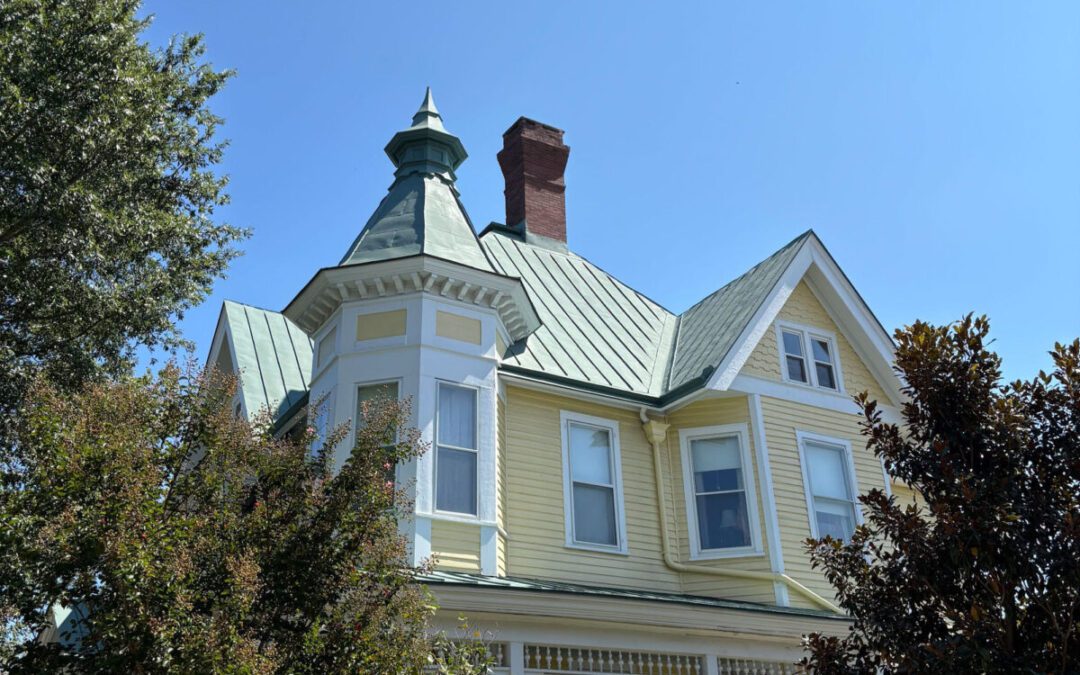
How NC’s Howe family, descended from an enslaved man, helped give Wilmington its distinctive look
North Carolina's Howe family traces their lineage back to an enslaved man who was forced to work construction projects. His descendants have helped...
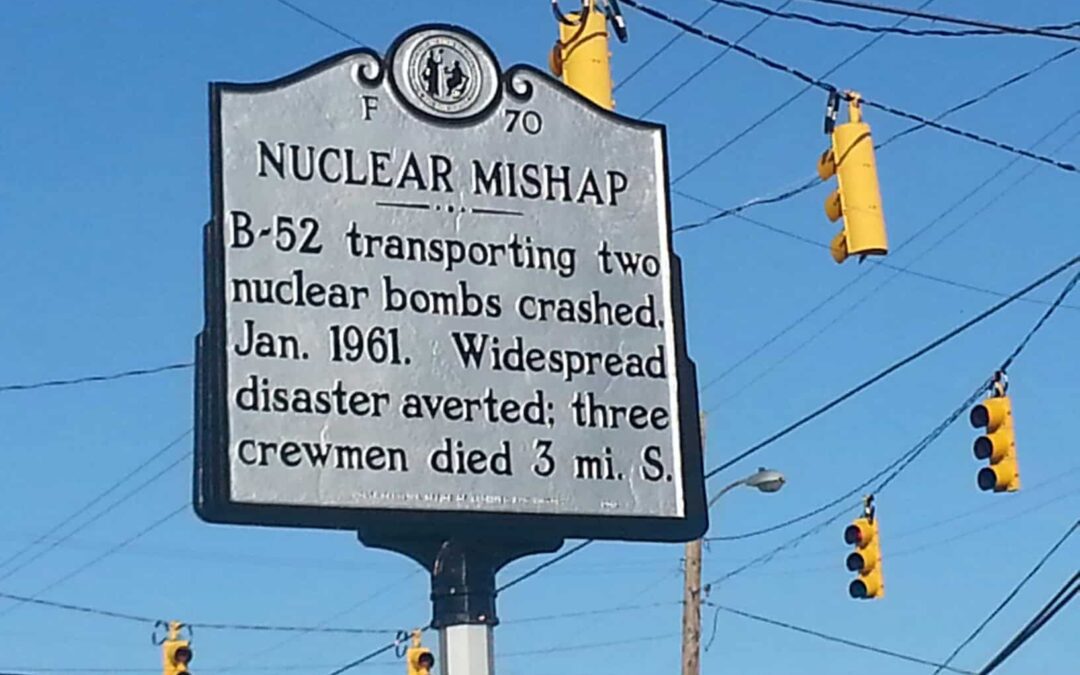
5 creepy things you never knew about North Carolina
These lesser-known facts and stories about North Carolina will make your hair stand on end. Learning more about the state you live in is never a...
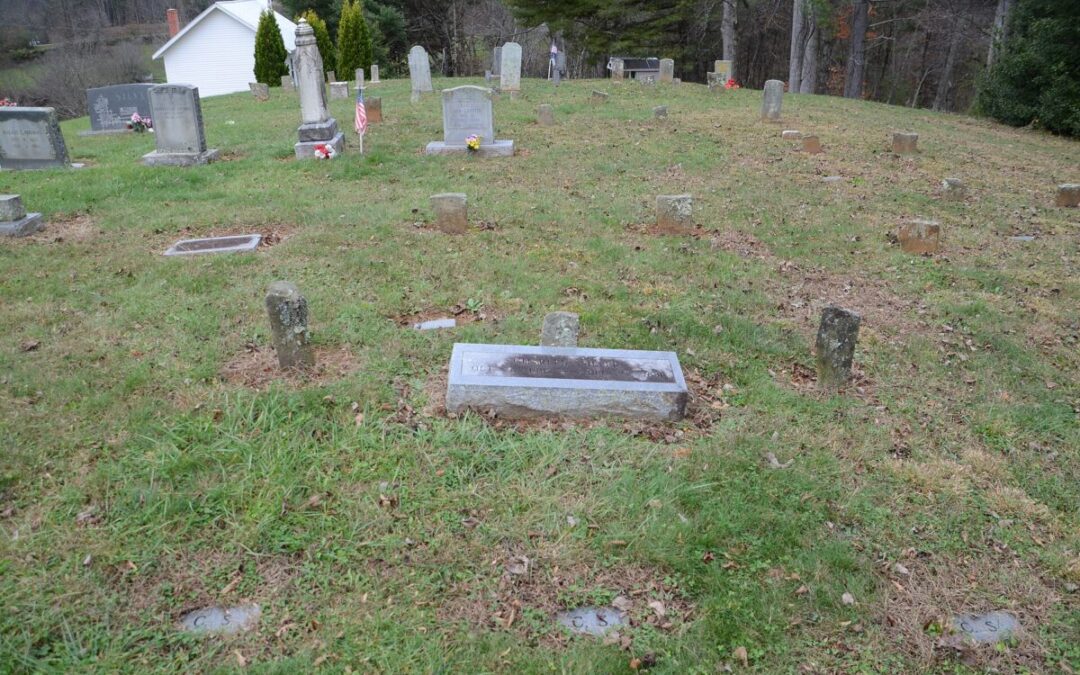
The real ballad of Frankie Silver, one of the first women executed in North Carolina
Frankie Silver is believed to be the first white woman executed in North Carolina. Here’s the real story of what happened to her back in the 1830s....

The real ballad of Frankie Silver, one of the first women executed in North Carolina
Frankie Silver is believed to be the first white woman executed in North Carolina. Here’s the real story of what happened to her back in the 1830s....
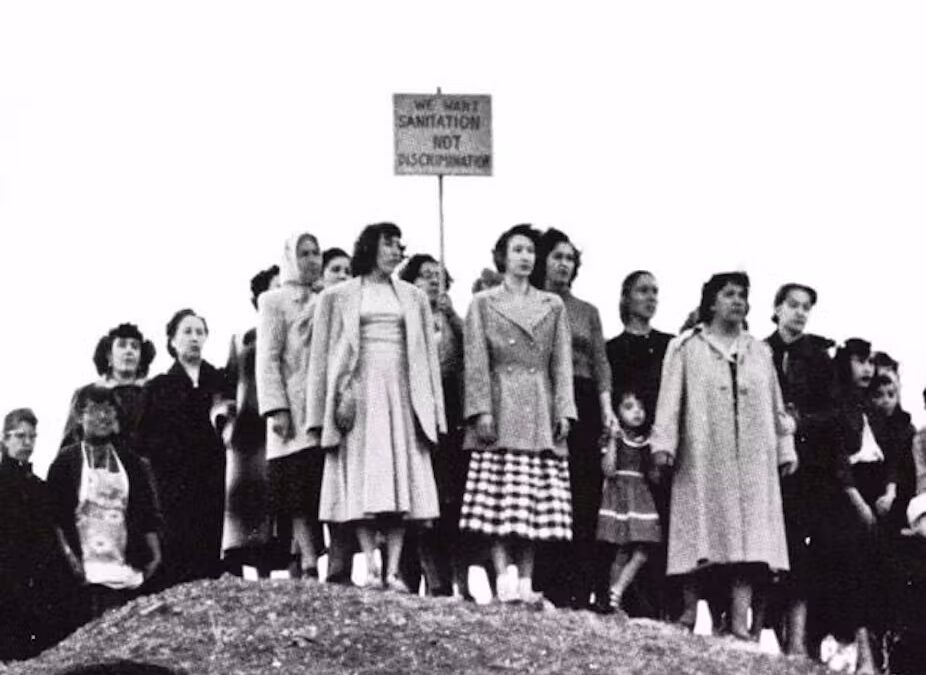
5 unsung films that dramatize America’s rich labor history
By Peter Dreier, Occidental College The U.S. is in the midst of a new upsurge of union organizing. Is a Hollywood drama about angry Starbucks...







